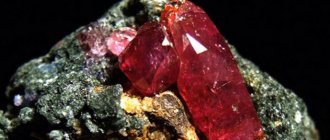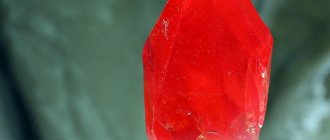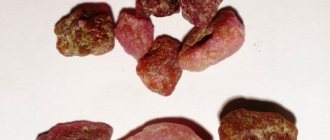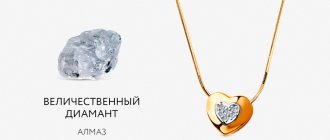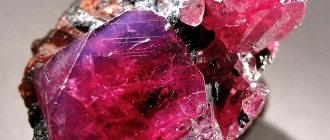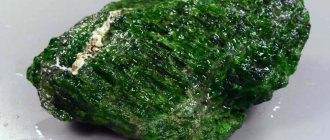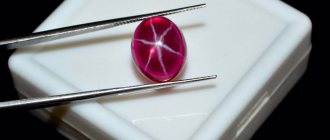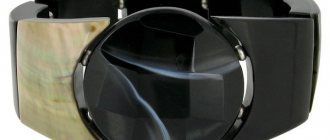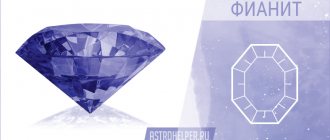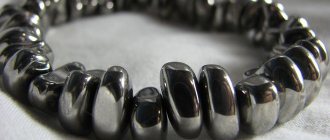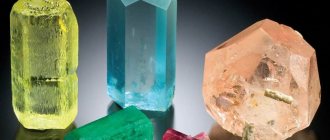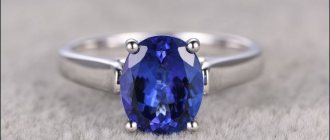Hello, dear friends. We can talk about precious stones forever, because their beauty has fascinated us since ancient times. A blood-red ruby, the outdated name of which 3 letters filled with awe and expectation to see a miracle, was previously called “lal”. This gem is described in many legends and traditions. There is an opinion that the ancient name gradually turned into the word “scarlet”, which is well known to each of us. Let's plunge today into the world of legends and stories about a beautiful stone, which even today fascinates with its beauty.
Description of the stone
Ruby is a top class gemstone. Its color is due to impurities of aluminum and chromium. The more impurities, the richer the red color. The best rubies are those from Burma and Thailand. These are some of the most expensive jewelry gems.
Ancient legends say that the gem is soaked in the blood of a dragon, which is why it has a bright red color and high hardness. In Rus', ruby was believed to be a means of driving away spirits and nightmares.
A real high quality mineral looks like this:
- transparent;
- different shades of red;
- brilliant;
- smooth;
- heavy.
Crystals, even untreated, have the correct shape of a prism or cylinder. A natural ruby may be of low quality, in which case it is considered an ornamental one. The value of the stone is not only jewelry, but also industrial. Minerals such as garnet and red spinel are similar to ruby. But unlike him, they are not precious.
View this post on Instagram
Posted by Stones and Jewelry TopGems (@kamni_topgems) Apr 30, 2018 at 7:56 am PDT
Varieties and colors
The classic color of the mineral is red. However, there are stones of other shades, sometimes not even red:
- pink - found on the island of Sri Lanka;
- purple - called “pigeon blood”;
- dark, closer to brown, mined in Thailand.
The mineral does not have any other colors. The black stone, which has characteristics similar to ruby, is a type of spinel and is very rare. Green, blue and blue gems are the same group of corundum, but they are called sapphires and have differences in chemical composition.
Star gems are of high value - a six-pointed star formed by rutile inclusions is clearly visible inside them. Opaque crystals are valued much lower. Before making jewelry, they are subjected to heat treatment.
In addition to watching the video about the stone:
What were rubies called in Rus'?
In ancient times, the ancient Slavs also became acquainted with beautiful gems. Of course, only a few saw them, much less owned them. Today we know what precious corundums were called back then. They had the name yakhonty. It referred to rubies and sapphires.
According to linguists, the word “yakhont” originates from the Arabic word “Yakut”. This is what merchants from the Middle East called brightly colored gems. In ancient times, such a product was a real rarity that attracted rich people and rulers.
The Slavs called rubies red yakhont, sapphires were called azure yakhont. Rubies were endowed with special magical properties, the ability to heal not only the soul, but also the human body. Large red stones decorated the treasuries and crowns of the rulers of eastern countries.
Russian tsars also had a special love for rubies. Needless to say, more than 100 rubies were skillfully used to decorate the royal scepter. The Great Empress Catherine the Second received a wonderful gift during her reign. She was presented with a ruby the size of a pigeon's egg. This gift suited the great empress perfectly and was worthy of her beauty, power and wisdom.
During the Middle Ages, red yakhont was valued by kings and nobility even more than the most beautiful diamonds. In European countries, the deep red gem was commonly called carbuncle, burning coal or anthrax.
History and origin of the mineral
Ruby has been known to man since BC. In India, the gem was considered the king of precious stones and was used to decorate crowns and create talismans. Among all peoples, the mineral was considered a companion of kings and other noble persons. In ancient Asia, rubies, diamonds and sapphires were combined under the name “corundum”. The ancient Russian name for the mineral is “yakhont”; it was considered a talisman against bad dreams.
According to Indian legend, the stone was tempered with the blood of the demon Vala. The sun god Surya dropped a vessel of blood into the Bhakarta River. According to the legends of other nationalities, the gem came from the blood of a dragon.
In 1800, European scientists discovered the relationship between sapphires and rubies. Blue corundum began to be called sapphire, and scarlet corundum became ruby. In the article about cornwood ruby, read how it differs from a regular ruby.
In 1835, a method for producing artificial stones was discovered.
Among the famous crystals are:
- Burmese “pigeon blood” ruby weighing 25 carats - sold at Sotheby’s for $30 million, becoming the most expensive ruby in history;
- another expensive piece - a crystal in a Bulgari ring weighing 8.6 carats and worth $5 million;
- the largest crystal was found in Greenland, it has not yet been given a name - its mass is 440 carats.
Crystals are found in limestones, mica veins, and igneous rocks.
One of the wedding anniversaries is associated with the name of the gem. The ruby wedding is celebrated after 40 years from the date of marriage. On this anniversary, it is customary to exchange old wedding rings for new ones. They must be inlaid with rubies. Old rings are given to grandchildren as wedding gifts. It is customary for spouses to give items reminiscent of the red gem - 40 bottles of red wine, a photo album made of red leather.
Continue watching the story about the stone:
Questions/answers ❓
The topic of rubies is huge. Anything not mentioned, please ask. We'll try to answer.
How to distinguish a fake?
The most accurate method is to enlist the help of a specialist. Without specialists and special equipment, red spinel cannot be distinguished from ruby.
Buy stone from places that will provide you with a certificate.
If you want to play gemologist yourself:
- In ultraviolet light, natural ruby glows like a hot coal; the synthetic one will turn orange-crimson.
- Place the stone on your eyelid, cheek, and nose. It takes a long time to warm up - there is hope that the ruby is natural. A cheap fake will quickly warm up.
- Compare the color of the stone in daylight and artificial light. Natural ruby is darker in artificial light.
- Scratch the edge of the coin along the crystal. A trace remains - in the hands of a fake. A natural ruby can only be scratched by a diamond.
How to care?
A durable and strong stone, this lal. Only a diamond can scratch it.
However, there are subtleties in caring for it:
- Stones may have internal mechanical stress. Under the influence of ultrasound or rapid heating, these forces can destroy the stone.
- Many rubies are refined, their cracks are “healed” and filled with special compounds. When cleaning with steam or ultrasound, defects in the stone can behave unpredictably.
- Therefore, despite the hardness of the stone, of all types of cleaning it is recommended to use the ancient and ageless method - warm soapy water and a soft cloth.
How to wear?
The best setting for a ruby is gold.
- It is better for men to purchase jewelry with a dark-colored ruby.
- For women, the best stone colors are sangena and rose. Padparadscha is also good.
What is the price?
Burmese rubies, with other identical characteristics, are more expensive.
Compare approximate ruby prices.
| Rubies from unknown origin, carat weight | Carat value in US$ |
| Up to 1 | 350-4000 |
| 1-3 | 4000-12000 |
| 3-5 | 12000-24000 |
| 5-8 | 18000-34000 |
But the prices for Burmese untreated rubies are of the highest quality.
| Crystal weight in carats | Carat value in US$ |
| Up to 1 | 6500-13000 |
| From 1 to 3 | 15000-35000 |
| From 3 to 5 | 35000-60000 |
What colors are there?
By color shade, rubies are defined as:
- Dark red;
- medium red;
- bright red;
- medium red;
- light red;
- red.
Where can I buy?
Abroad - in places where stones are mined. But not in all of them.
Bangkok hosts annual February exhibitions. There you can buy precious stones with a guarantee.
Important: unmounted rubies (like sapphire and alexandrite) must only be sold with a certificate (by law). However, in Russia there is no system for their certification. This is such a paradox. If you buy an unmounted natural ruby, you risk getting in trouble with the law.
What does the price consist of?
These are several factors:
- color;
- weight;
- cutting;
- ennoblement (whether it was, and what);
- transparency, purity;
- origin.
Note : the best rubies are Burmese. In second place are Thai, brownish ones.
Kenyan stones have a yellowish or brownish tint.
When is the best time to buy?
To the spouses for 40 years of marriage. This is a ruby wedding.
Whenever you buy a natural ruby, do not rush to wear it. It is better to update the decoration when the Sun is in the constellation Leo or Aries.
What stones does it go with?
The energy of ruby is so strong that it is better to wear the stone without “companions”. As a last resort, you can complement the look with black and white gems.
But the second ruby is very suitable for the first. Esotericists believe that a single ruby attracts loneliness to the owner.
For your information: P. Globa believes that red ruby and black obsidian are astrologically incompatible.
Are all the stones in Soviet jewelry artificial?
Yes. Alexandrites, sapphires, rubies - they are all synthetic.
The fact is that jewelry for the people was a good source of income for the state. But rubies were not found in the USSR. But the production of corundum was well established and worked out. The stones were of the highest quality. They were produced for watches, then for lasers. Soviet synthetic alexandrites were in great demand in the West.
But our women also wore jewelry with “precious stones.”
Mining and stone processing
Ruby can be found on any continent except Antarctica. Large deposits are located:
- in Asia;
- Thailand;
- Myanmar;
- Tajikistan;
- Kenya;
- Tanzania.
In Russia, ruby is mined in the Polar Urals, Karelia, and the Kola Peninsula.
Gem-quality crystals make up only 1% of the total production, which is why ruby jewelry is so highly prized. Rock mining today is carried out in the old way - miners manually wash the ore and extract crystals from the bottom of rivers and lakes.
Asian gems are the most valuable. The Burmese ruby, which has a rare color, is considered to be the highest quality stone. For many centuries, Indian gems, which are the most ancient, have been used to inlay crowns and symbols of power.
Crystals of the highest quality are cut into diamonds, while those of a slightly lower quality are cut into cabochons. For industrial purposes, raw mineral ruby chips are used. For crystals of low quality, a refining process is used. They are calcined at a temperature of 1800 degrees, which destroys inclusions of other minerals and increases the transparency of the stone. Another way to improve quality is to fill cracks with lead glass.
Here's a video of what a cut stone looks like:
Artificial ruby
The synthetic mineral is produced in laboratories under conditions close to natural. The stone can be grown from a corundum melt at high pressure and temperatures of more than 1500 degrees. The procedure is called the hydrothermal method.
Read more about synthetic corundum here.
Synthetic crystals are initially white; they are colored later. Painting is done by spraying tiny particles of chromium. The colored stone is called nano ruby because the chromium particles are hundreds of times smaller than a millimeter.
This mineral is not counterfeit, because its chemical composition is identical to the natural one.
How to distinguish a real ruby from a fake
Due to its rarity and high cost, the stone is often counterfeited. Signs of a real mineral:
- when examined under a magnifying glass, tiny inclusions are visible;
- greater weight compared to glass or plastic fakes;
- a crystal placed in a glass of milk turns it pinkish;
- turns orange in ultraviolet rays;
- has a cool surface.
By these characteristics, a natural ruby can be distinguished from glass or plastic. It is possible to make a plastic fake even at home. But synthetic stone is obtained only in special laboratories; only an expert can distinguish it from natural stone.
Properties and uses of ruby
Gem-quality rubies are used to make jewelry. Ornamental and synthetic ruby crystals are used in the watch industry, laser manufacturing, and electronics.
Physicochemical characteristics
The chemical formula of the mineral is Al2O3, aluminum oxide. The composition also contains chromium atoms, which give the red color. Physical properties of the mineral:
- hardness - 9 units on the Mohs scale, second only to diamond;
- glass shine;
- density 4 grams per cubic centimeter;
- imperfect cleavage;
- double refraction of light;
- The crystal lattice is trigonal.
The purity of rubies is determined by the number of defects after cutting:
- first quality group - clean or with rare defects in the form of dots or stripes;
- second quality group - small cracks, stripes, inclusions of other minerals;
- the third quality group is cracks widespread throughout the crystal, inclusions of other minerals, and areas of opacities.
To improve their characteristics, the stones undergo additional processing.
Medicinal properties
Lithotherapists point to the ability of ruby to help with diseases:
- spine and joints;
- digestive system;
- kidneys, bladder;
- liver, gall bladder;
- respiratory tract.
The mineral has hemostatic properties, relieves fever, and normalizes sleep. For therapeutic purposes, the stone is placed on the area of the disturbing organ.
To normalize sleep and avoid nightmares, the gem is placed under the pillow.
Also watch the video from the lithotherapist:
Magic properties
Ruby is a talisman for warriors. This stone is suitable for strong-willed people, helping them to withstand difficulties and not succumb to the influence of others. Ruby talismans help you to know yourself and find inner harmony.
People who are unbalanced, cruel, or with an excessive thirst for power should not wear the mineral. Under the influence of a gem, they can commit rash acts.
The magic of the gem has long been associated with love. Ruby amulets help a person build love relationships and find family happiness. Pink shades of the mineral symbolize tender romantic feelings, and deep red shades symbolize strong passion. The stone is considered an active aphrodisiac that awakens the senses. Amulets are worn on a chain in the form of a pendant or on the index finger of the left hand.
Ruby amulets are used in various life situations:
- protection against poisoning;
- expulsion of bad thoughts;
- maintaining good health;
- strengthening mental abilities;
- improvement of financial situation.
Ruby is a symbol of transformation. It helps to change any life situations for the better, showing a person the true path.
Ruby amulets are useful for scientists, writers, directors, travelers, and students. For women, a ruby talisman will help them get pregnant.
Suitable by zodiac sign and name
Ruby is considered the patron saint of those born in July. This means that talismans should be worn by Leos and Cancers. Representatives of other signs can wear ruby items, but their properties will be slightly expressed.
The stone belongs to the element of Fire, its representatives are also Aries and Sagittarius. A ruby item is suitable for Scorpio, since it is protected by the same planet Mars.
It is not advisable for Virgos and Taurus to wear the stone.
The effect of the mineral on representatives of different zodiac signs:
- Leo - increases luck, helps achieve goals, gives vital energy;
- Scorpio - helps control emotions;
- Capricorn - protects against diseases, strengthens the immune system;
- Pisces - helps solve life's difficulties;
- Aries - protects from dangers;
- Aquarius - will help develop creative abilities;
- Sagittarius - relieves stress;
- Gemini - balances character.
It is recommended to choose the gem for people with strong names - Victor, Alexander, Dmitry, Veronica, Larisa, Angelina.
Continuing the topic, video review:
Why do you dream about a ruby?
If you look in the dream book, ruby is interpreted depending on the situation:
- a dream of a ruby ring foreshadows a passionate relationship, but if the ring is lost, this indicates a cooling of feelings;
- if a ruby was given as a gift in a dream, this indicates an upcoming promotion;
- a broken crystal means a serious illness;
- finding a ruby jewelry in a dream means quick success.
Almost all dreams with a ruby mean financial and career changes, building or losing a love relationship.
Magic properties
Fire is the native element of rubies.
The stone protects its owner even in the midst of ill-wishers and makes him invulnerable. For this purpose, the ruby is worn on the body, hidden by clothing, and the amulet is not removed. But it is worth considering that the influence of the stone depends on the qualities of the person: thus, a ruby makes a kind, good owner noble and persistent in the pursuit of a goal, and only strengthens the negative character traits of evil people.
Rubies are responsible for leadership and responsibility, they help overcome complexes and lack of self-confidence, awaken love and craving for great things, arts, sciences, and military affairs.
Ruby also symbolizes passionate carnal love.
Jewelry with ruby
A gem can coexist with other precious or semi-precious minerals - amethyst, pearl, emerald, sapphire, turquoise. Does not combine with malachite, onyx, obsidian. Behaves neutrally with topaz.
Ruby jewelry can be elite, made from high-quality natural stones. Middle class jewelry is made from low quality stones and synthetic crystals. Despite the bright color, ruby products do not look vulgar and are suitable for anyone, regardless of gender and age.
Men's jewelry includes rings, cufflinks, and tie clips. Watches, lighters, and cigarette cases are encrusted with stones. Products for women include rings, earrings, necklaces, and bracelets. Brooches and hair clips are decorated with red stones.
Ruby is considered an evening jewel. It is worn for special occasions, family holidays, and romantic dates. Ruby sets go well with an evening or cocktail dress.
For a work environment, jewelry with small crystals, such as stud earrings, is suitable.
View this post on Instagram
Posted by BLUEBOXMOSCOW (@blueboxmoscow) Jun 28, 2019 at 1:34 PDT
View this post on Instagram
Posted by almaz_tomsk (@almaz_tomsk) Jul 18, 2022 at 3:32 PDT
View this post on Instagram
Posted by LOMBARD-KRISTALL (@lombardkristall.blg) Oct 9, 2019 at 9:29 am PDT
Stone care
Ruby items are stored in a separate box, lined with soft fabric on the inside. They are not afraid of exposure to sunlight and are resistant to acids and alkalis.
Clean the product from dirt with soapy water and a soft brush. Dry naturally or wipe with a cloth. Once a year, it is recommended to take the item for professional jewelry cleaning.
